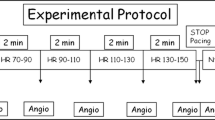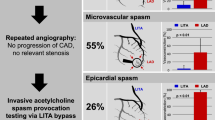Abstract
Background
Coronary angiography is often performed in patients with recurrent or ongoing angina after successful percutaneous coronary intervention (PCI) in search of an in-stent restenosis (ISR). However, in many of these patients, no significant ISR can be detected. We speculate that enhanced coronary vasoconstriction represents an alternative explanation for angina in these patients.
Methods
From 1,285 patients with angiographically unobstructed coronaries (no stenosis ≥50 %) who underwent intracoronary acetylcholine provocation testing (ACH-test) between 2008 and 2011, we consecutively recruited 104 patients (42 female (40 %), mean age 64 ± 11 years) who fulfilled the following inclusion criteria: previous stent implantation due to obstructive coronary artery disease (CAD), ongoing/recurrent exertional angina, no significant (<50 %) ISR.
Results
In fifty-one patients with previous PCI (49 %), the ACH-test elicited enhanced epicardial vasoconstriction (≥75 % diameter reduction with reproduction of the patient’s symptoms) and microvascular vasoconstriction (reproduction of symptoms, ischemic ECG-changes and no epicardial vasoconstriction) was seen in 18 additional patients (17 %). The ACH-test was uneventful in the remaining 35 patients (34 %). Epicardial vasoconstriction in patients with previous PCI was most often distal and diffuse (31/51, 61 %, p < 0.01).
Conclusion
Enhanced epicardial and microvascular coronary vasoconstrictions are frequently found in patients with stable angina after successful PCI but without significant ISR. Intracoronary acetylcholine provocation testing may be useful in these patients to determine the cause of angina and initiate appropriate medical treatment.




Similar content being viewed by others
Abbreviations
- ACH:
-
Acetylcholine
- BMS:
-
Bare metal stent
- CAD:
-
Coronary artery disease
- DES:
-
Drug eluting stent
- ECG:
-
Electrocardiogram
- ISR:
-
In-stent restenosis
- LCA:
-
Left coronary artery
- RCA :
-
Right coronary artery
References
Shah BR, Cowper PA, O’Brien SM et al (2010) Patterns of cardiac stress testing after revascularization in community practice. J Am Coll Cardiol 56:1328–1334
Ong P, Athanasiadis A, Borgulya G et al (2012) High prevalence of a pathologic response to acetylcholine testing in patients with stable angina pectoris and unobstructed coronary arteries. The ACOVA study (Abnormal COronary VAsomotion in patients with stable angina and unobstructed coronary arteries). J Am Coll Cardiol 59:655–662
el-Tamimi H, Davies GJ, Sritara P et al (1991) Inappropriate constriction of small coronary vessels as a possible cause of a positive exercise test early after successful coronary angioplasty. Circulation 84:2307–2312
Monnink S, Tio R, Veeger N et al (2003) Exercise-induced ischemia after successful percutaneous coronary intervention is related to distal coronary endothelial dysfunction. J Invest Med 51:221–226
el-Tamimi H, Davies GJ, Crea F et al (1993) Response of human coronary arteries to acetylcholine after injury by coronary angioplasty. J Am Coll Cardiol 21:1152–1157
Azar RR (2010) Diffuse coronary spasm in a patient with a recent stent. JACC Cardiovasc Interv 3:459–460
Fox K, Garcia MA, Ardissino D et al (2006) Guidelines on the management of stable angina pectoris: executive summary: the task force on the management of stable angina pectoris of the European society of cardiology. Eur Heart J 27:1341–1381
Hamm CW, Bassand JP, Agewall S et al (2011) ESC Guidelines for the management of acute coronary syndromes in patients presenting without persistent ST-segment elevation: the Task Force for the management of acute coronary syndromes (ACS) in patients presenting without persistent ST-segment elevation of the European Society of Cardiology (ESC). Eur Heart J. doi:10.1093/eurheartj/ehr236
Lüscher TF, Pieper M, Tendera M et al (2009) A randomized placebo-controlled study on the effect of nifedipine on coronary endothelial function and plaque formation in patients with coronary artery disease: the ENCORE II study. Eur Heart J 30:1590–1597
Ong P, Athanasiadis A, Hill S et al (2008) Coronary artery spasm as a frequent cause of acute coronary syndrome: the CASPAR (coronary artery spasm in patients with acute coronary syndrome) Study. J Am Coll Cardiol 52:523–527
Mohri M, Koyanagi M, Egashira K et al (1998) Angina pectoris caused by coronary microvascular spasm. Lancet 351:1165–1169
Austen WG, Edwards JE, Frye RL, et al. (1975) A reporting system on patients evaluated for coronary artery disease. Report of the Ad Hoc Committee for Grading of Coronary Artery Disease, Council on Cardiovascular Surgery, American Heart Association. Circulation. 51(4 Suppl):5–40
Sueda S, Kohno H, Fukuda H et al (2002) Clinical and angiographical characteristics of acetylcholine- induced spasm: relationship to dose of intracoronary injection of acetylcholine. Coron Artery Dis 13:231–236
Versaci F, Gaspardone A, Tomai F et al (2002) Chest pain after coronary artery stent implantation. Am J Cardiol 89:500–504
Mc Fadden EP, Bauters C, Lablanche JM et al (1993) Response of human coronary arteries to serotonin after injury by coronary angioplasty. Circulation 88:2076–2085
Katoh D, Mizuno Y, Harada E et al (2012) High incidence of provoked coronary spasm in the presence of a stent after myocardial infarction: therapeutic and prognostic implications. Coron Artery Dis. doi:10.1097/MCA.0b013e32835115ee
Lim S-H, Flammer AJ, Yoon MH et al (2012) The long-term effect of coronary stenting on epicardial and microvascular endothelial function. Circ Cardiovasc Interv 5:523–529
Ito S, Nakasuka K, Morimoto K et al (2011) Angiographic and clinical characteristics of patients with acetylcholine-induced coronary vasospasm on follow-up coronary angiography following drug-eluting stent implantation. J Invasive Cardiol 23:57–64
Shiroto T, Yasuda S, Tsuburaya R et al (2009) Role of Rho-kinase in the pathogenesis of coronary hyperconstricting responses induced by drug-eluting stents in pigs in vivo. J Am Coll Cardiol 54:2321–2329
Togni M, Windecker S, Cocchia R et al (2005) Sirolimus-eluting stents associated with paradoxic coronary vasoconstriction. J Am Coll Cardiol 46:231–236
Tran CH, Welsh DG (2010) The differential hypothesis: a provocative rationalization of the conducted vasomotor response. Microcirculation 17:226–236
Indolfi C, Piscione F, Rapacciuolo A et al (1994) Coronary artery vasoconstriction after successful single angioplasty of the left anterior descending artery. Am Heart J 128:858–864
Ozaki Y, Keane D, Serruys PW (1995) Fluctuation of spastic location in patients with vasospastic angina: a quantitative angiographic study. J Am Coll Cardiol 26:1606–1614
Sun H, Mohri M, Shimokawa H et al (2002) Coronary microvascular spasmvasoconstriction causes myocardial ischemia in patients with vasospastic angina. J Am Coll Cardiol 39:847–851
Ong P, Athanasiadis A, Mahrholdt H et al (2012) Increased coronary vasoconstrictor response to acetylcholine in women with chest pain and normal coronary arteriograms (cardiac syndrome X). Clin Res Cardiol 101:673–681
Miwa K, Fujita M, Sasayama S (2005) Recent insights into the mechanisms, predisposing factors, and racial differences of coronary vasospasm. Heart Vessels 20:1–7
Davignon J, Ganz P. (2004) Role of endothelial dysfunction in atherosclerosis. Circulation. 109:III27–32
Förstermann U, Mügge A, Alheid U et al (1988) Selective attenuation of endothelium-mediated vasodilation in atherosclerotic human coronary arteries. Circ Res 62:185–190
Seddon M, Melikian N, Dworakowski R et al (2009) Effects of neuronal nitric oxide synthase on human coronary artery diameter and blood flow in vivo. Circulation 119:2656–2662
Kajander S, Joutsiniemi E, Saraste M et al (2010) Cardiac positron emission tomography/computed tomography imaging accurately detects anatomically and functionally significant coronary artery disease. Circulation 122:603–613
Ong P, Athanasiadis A, Borgulya G, et al.(2012) Clinical usefulness and safety evaluation of intracoronary acetylcholine provocation testing among 1000 consecutive Caucasian patients with anginal symptoms and unobstructed coronary arteries. J Am Coll Cardiol. 59(13s1):E1487–E1487. doi:10.1016/S0735-1097(12)61488-0
Lin GA, Dudley RA, Lucas FL et al (2008) Frequency of stress testing to document ischemia prior to elective percutaneous coronary intervention. JAMA 300:1765–1773
Acknowledgments
The authors are grateful to nurses and technicians in the catheterization laboratories and to all staff members, especially Nathalie Konopka, of the Department of Cardiology, Robert-Bosch-Krankenhaus, Stuttgart, Germany for their help and support during the study.
Conflict of interest
On behalf of all authors, the corresponding author states that there is no conflict of interest
Author information
Authors and Affiliations
Corresponding author
Additional information
P. Ong and A. Athanasiadis contributed equally to this study.
Rights and permissions
About this article
Cite this article
Ong, P., Athanasiadis, A., Perne, A. et al. Coronary vasomotor abnormalities in patients with stable angina after successful stent implantation but without in-stent restenosis. Clin Res Cardiol 103, 11–19 (2014). https://doi.org/10.1007/s00392-013-0615-9
Received:
Accepted:
Published:
Issue Date:
DOI: https://doi.org/10.1007/s00392-013-0615-9




